| This article needs additional citations for verification. Please help improve this article by adding citations to reliable sources. Unsourced material may be challenged and removed. Find sources: "Gardena, California" – news · newspapers · books · scholar · JSTOR (July 2024) (Learn how and when to remove this message) |
| Gardena, California | |
|---|---|
| City | |
 The United States Post Office in Gardena The United States Post Office in Gardena | |
 Flag Flag Seal Seal | |
| Nickname: "Freeway City" | |
| Motto: "The City of Opportunity!" | |
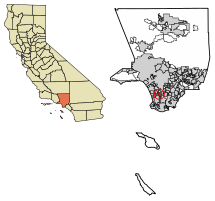 Location of Gardena in Los Angeles County, California Location of Gardena in Los Angeles County, California | |
 | |
| Coordinates: 33°53′37″N 118°18′28″W / 33.89361°N 118.30778°W / 33.89361; -118.30778 | |
| Country | |
| State | |
| County | Los Angeles |
| Incorporated | September 11, 1930 |
| Government | |
| • Mayor | Tasha Cerda |
| • Mayor Pro Tem | Rodney G. Tanaka |
| • City Council | Mark E. Henderson Paulette C. Francis Wanda Love |
| Area | |
| • Total | 5.86 sq mi (15.19 km) |
| • Land | 5.83 sq mi (15.10 km) |
| • Water | 0.04 sq mi (0.09 km) 0.61% |
| Elevation | 49 ft (15 m) |
| Population | |
| • Total | 61,027 |
| • Density | 10,000/sq mi (4,000/km) |
| Time zone | UTC−8 (PST) |
| • Summer (DST) | UTC−7 (PDT) |
| ZIP Codes | 90247–90249 |
| Area codes | 310/424 |
| FIPS code | 06-28168 |
| GNIS feature IDs | 1660664, 2410570 |
| Website | www |
Gardena is a city located in the South Bay region of Los Angeles County, California, United States. The population was 58,829 at the 2010 census, up from 57,746 at the 2000 census. Until 2014, the U.S. census cited the City of Gardena as the place with the highest percentage of Japanese Americans in California. Gardena's Japanese American population contributes to the South Bay region of Los Angeles being home to the highest density of Japanese companies within the mainland United States.
History
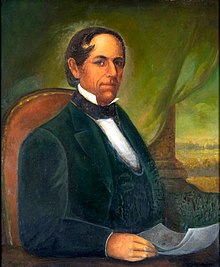
Based on archaeological findings, the Tongva people hunted and fished in the area of today's Gardena. The Tongva Indians — also known as Gabrielino Indians — are probably descendants of those who crossed from Asia to North America around 10,000 years ago.
In 1784, three years after the foundation of Los Angeles, Juan Jose Dominguez (1736–1809), a Spanish soldier who arrived in San Diego, California in 1769 with Fernando Rivera y Moncada, in recognition of his military service, received the roughly 43,000-acre (170 km) Spanish land grant, the Rancho San Pedro. Part of this land contained what became known as Gardena Valley. After the American Civil War veterans bought parts of the land, and soon ranchers and farmers followed suit. Union Army Major General William Starke Rosecrans in 1869 bought 16,000 acres (65 km). The "Rosecrans Rancho" was bordered by what later was Florence Avenue on the north, Redondo Beach Boulevard on the south, Central Avenue on the east, and Arlington Avenue on the west. The Rosecrans property was subdivided and sold in the early 1870s. One of those became the 650-acre (2.6 km) Amestoy Ranch. Gardena proper began in 1887 when the Pomeroy & Harrison real estate developers subdivided the ranch, anticipating the coming of the Los Angeles and Redondo Railway. Civil War veteran Spencer Roane Thorpe is credited with starting the first settlement in Gardena in 1887. Railroads put Gardena on the map following a 1880s Southern California real estate boom.
Some believe the city was named for its reputation for being the only "green spot" in the dry season between Los Angeles and the sea. Because of its acres of berries, the city was dubbed "Berryland". The Strawberry Day Festival and Parade was held each May. The berry industry suffered at the time of World War I as other crops were supported by the war economy.
Japanese Americans settled in Gardena throughout its history. The only way Gardena could protect itself from a heavy county tax imposed on a planned project at a park site was to incorporate. The City of Gardena became incorporated on September 11, 1930.
From 1936 to 1980, Gardena held a local monopoly on legal cardrooms, the taxes from which accounted for nearly a third of its annual budget. As this Los Angeles suburb grew, many Japanese American families moved into the new tract homes being built.
Geography
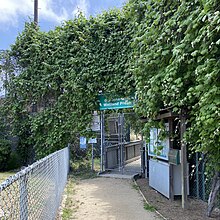
According to the United States Census Bureau, the city has a total area of 5.9 square miles (15 km), over 99% of which is land. A 9.4-acre (3.8 ha) wetland preserve, the Gardena Willows Wetland Preserve, is located at the southeast corner of Gardena. This is a naturally occurring marshland where water seeps above-ground all year round. It hosts several species of trees and other vegetation.
Gardena is bordered by the unincorporated community of Athens on the north, the Los Angeles neighborhood of Harbor Gateway on the east and south, Torrance on the southwest, Alondra Park on the west, and Hawthorne on the northwest.
Neighborhoods in Gardena include:
- Hermosillo
- Moneta
- Strawberry Park
Demographics
| Census | Pop. | Note | %± |
|---|---|---|---|
| 1940 | 5,909 | — | |
| 1950 | 14,405 | 143.8% | |
| 1960 | 35,943 | 149.5% | |
| 1970 | 41,021 | 14.1% | |
| 1980 | 45,165 | 10.1% | |
| 1990 | 49,847 | 10.4% | |
| 2000 | 57,746 | 15.8% | |
| 2010 | 58,829 | 1.9% | |
| 2020 | 61,027 | 3.7% | |
| U.S. Decennial Census | |||
2010
The 2010 United States Census reported that Gardena had a population of 58,829. The population density was 10,030.0 inhabitants per square mile (3,872.6/km). The racial makeup of Gardena was 14,498 (24.6%) White (9.3% Non-Hispanic White), 14,352 (24.4%) African American, 348 (0.6%) Native American, 15,400 (26.2%) Asian, 426 (0.7%) Pacific Islander, 11,136 (18.9%) from other races, and 2,669 (4.5%) from two or more races. There were 22,151 people of Hispanic or Latino origin, of any race (37.7%).
The Census reported that 58,035 people (98.7% of the population) lived in households, 122 (0.2%) lived in non-institutionalized group quarters, and 672 (1.1%) were institutionalized.
There were 20,558 households, out of which 7,199 (35.0%) had children under the age of 18 living in them, 8,782 (42.7%) were opposite-sex married couples living together, 3,931 (19.1%) had a female householder with no husband present, 1,486 (7.2%) had a male householder with no wife present. There were 1,085 (5.3%) unmarried opposite-sex partnerships, and 104 (0.5%) same-sex married couples or partnerships. 5,142 households (25.0%) were made up of individuals, and 1,921 (9.3%) had someone living alone who was 65 years of age or older. The average household size was 2.82. There were 14,199 families (69.1% of all households); the average family size was 3.39.
The population was spread out, with 13,410 people (22.8%) under the age of 18, 5,353 people (9.1%) aged 18 to 24, 16,656 people (28.3%) aged 25 to 44, 15,086 people (25.6%) aged 45 to 64, and 8,324 people (14.1%) who were 65 years of age or older. The median age was 37.9 years. For every 100 females, there were 92.6 males. For every 100 females age 18 and over, there were 89.8 males.
There were 21,472 housing units at an average density of 3,660.8 per square mile (1,413.4/km), of which 9,852 (47.9%) were owner-occupied, and 10,706 (52.1%) were occupied by renters. The homeowner vacancy rate was 1.3%; the rental vacancy rate was 4.6%. 28,585 people (48.6% of the population) lived in owner-occupied housing units and 29,450 people (50.1%) lived in rental housing units.
During 2009–2013, Gardena had a median household income of $48,251, with 15.5% of the population living below the federal poverty line.
2000
As of the census of 2000, there were 57,746 people, 20,324 households, and 14,023 families residing in the city. The population density was 9,921.3 inhabitants per square mile (3,830.6/km). There were 21,041 housing units at an average density of 3,615.0 per square mile (1,395.8/km). The racial makeup of the city was 23.82% White, 25.99% Black or African American, 0.64% Native American, 26.82% Asian, 0.73% Pacific Islander, 16.94% from other races, and 5.05% from two or more races. 31.82% of the population were Hispanic or Latino of any race.
There were 20,324 households, out of which 33.5% had children under the age of 18 living with them, 44.5% were married couples living together, 18.1% had a female householder with no husband present, and 31.0% were non-families. 25.5% of all households were made up of individuals, and 8.2% had someone living alone who was 65 years of age or older. The average household size was 2.80 and the average family size was 3.38.
In the city, the population was spread out, with 25.8% under the age of 18, 8.7% from 18 to 24, 32.3% from 25 to 44, 20.9% from 45 to 64, and 12.4% who were 65 years of age or older. The median age was 34 years. For every 100 females, there were 95.1 males. For every 100 females age 18 and over, there were 91.4 males.
The median income for a household in the city was $38,988, and the median income for a family was $44,906. Males had a median income of $32,951 versus $29,908 for females. The per capita income for the city was $17,263. About 12.3% of families and 15.7% of the population were below the poverty line, including 22.3% of those under age 18 and 10.1% of those age 65 or over.
Mexican and Japanese were the most common ancestries. Mexico and Korea were the most common foreign places of birth.
1980
In 1980, about 31% of the population was Anglo white, 23% was black, 21% was Japanese, and 17% was Latino. The remainder included a Korean community that was increasing in size and Chinese, Filipino, and Native American people. The National Planning Data Corp. released projected figures in 1987 estimating that of the 50,000 residents, 26.3% were Anglo, 23% were black, 22.7 were Latino, and 28% were of other racial groups. By 1989, Anglo and Japanese residents tended to live in central and southern Gardena. Middle class black people began to move into the Hollypark area in northern Gardena in the 1960s, so the black population was concentrated there.
1970–1978
According to the 1970 U.S. Census, 56% of the population was White. Racial demographic changes occurred until 1978. That year, Mayor Edmond J. Russ declared that, according to a special 1978 census, the racial demographics of Gardena had stabilized.
Japanese Americans
See also: History of the Japanese in Los Angeles

Gardena has a large Japanese-American community. Until 2014, it had the second-highest concentration of Japanese Americans in any U.S. municipality, the first being Honolulu. As of 2014, the nearby city of Torrance holds the highest Japanese-American population in the 48 contiguous states.
The Japanese Cultural Institute (JCI) has been is located in Gardena since 1988, and offers cultural and social activities for Japanese Americans. The building used during that year was completed in 1976.
Early in Gardena's history, Japanese migrants played a role in the agrarian economy. The Japanese Association founded the Moneta Japanese Institute in 1911, and the Parents' Association founded the Gardena Japanese School in 1916. Beginning in the 1920s, Japanese American organizations, including the Moneta Gakuen, were established continuously around the current JCI site. The Moneta Gakuen operated a school until the World War II internment.
In 1942 the U.S. military moved the Japanese in Gardena to internment camps.
In 1966, for the first time, a Nisei, Kiyoto Ken Nakaoka, was seated on the city council. Nakaoka later became Gardena's mayor in 1972. In 1980, the city was 21% Japanese, and as of 1989, Japanese residents tended to live in the center and south of the city.
Korean Americans
See also: History of the Korean Americans in Los AngelesAs of 1992, about 60% of the Korean population in the South Bay region lived in Gardena and Torrance. By that year, many Korean businesses had been established in Gardena because its commercial land was more affordable than that of Torrance, a middle-class base, and it also had an established Asian population. In 1990, 2,857 ethnic Koreans lived in Gardena, a 209% increase from the 1980 figure of 924 ethnic Koreans.
Economy
Digital Manga is headquartered in Suite 300 at 1487 West 178th Street. Nissin Foods has its United States headquarters and a plant in Gardena. Nissin Foods (U.S.A.) Co., Inc. opened in Gardena in 1970. Marukai Corporation U.S.A. has its headquarters in Gardena. Nissan's North America headquarters were located in Gardena until they moved to Tennessee in 2006.
National Stores Inc., which operates the Factory 2-U and the Fallas Paredes brands, has its headquarters in the Harbor Gateway area of Los Angeles, near Gardena.

Top employers
According to the city's 2023 Annual Comprehensive Financial Report, the top employers in the city as of 2020 were:
| # | Employer | # of Employees |
|---|---|---|
| 1 | United Parcel Service Inc. | 789 |
| 2 | Gardena Memorial Hospital | 750 |
| 3 | Nissin Foods | 550 |
| 4 | Hustler Casino | 465 |
| 5 | Air Fayre | 289 |
| 6 | Avcorp | 289 |
| 7 | Larry Flynt's Lucky Lady Casino | 245 |
| 8 | Southwest Offset Printing | 235 |
| 9 | Kindred Hospital South Bay | 225 |
| 10 | Target | 200 |
Government
In the California State Legislature, Gardena is in the 35th Senate District, represented by Democrat Laura Richardson, and in the 66th Assembly District, represented by Democrat Al Muratsuchi.
In the United States House of Representatives, Gardena is in California's 43rd congressional district, represented by Democrat Maxine Waters.
Education
Primary and secondary schools
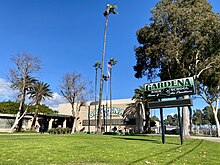
The Los Angeles Unified School District operates the city's public schools.
Zoned middle schools include:
- Peary Middle School
- Some areas in Gardena have a choice between Peary and Henry Clay Middle School. (Los Angeles)
Zoned high schools include:
- Gardena High School (Los Angeles)
In the spring of 1956, the junior high school classes stayed at the old Gardena High School while the high school classes moved into a new building. Up until the opening of the new Gardena High School, high school students held morning shifts, while junior high school students held afternoon shifts.
The northern end of the Gardena HS campus has LAUSD staff housing, Sage Park Apartments.
Private schools
The Roman Catholic Archdiocese of Los Angeles operates Catholic schools in Gardena, including Junípero Serra High School, Maria Regina Catholic School (K-8), and St. Anthony of Padua School (K-8). Pacific Lutheran Jr./Sr. High school, a 6-12 non-Catholic private school, is in Gardena. The Gardena Christian Academy, a PreK-2 Christian school, is in Gardena.
Infrastructure
Public services
The Gardena Office of Economic Development is a department of the city government. It aids employers in filling a variety of jobs customized to their specific needs. It also helps potential employers in setting up business enterprises.
The Gardena Police Department is the primary law enforcement agency in the city. The department has 89 sworn police officers, 24 full-time support staff, and 33 part-time employees. There are reserve, volunteer, and explorer programs. The current Chief of Police is Michael Saffell, appointed in 2020. Radio communications and the 9-1-1 call center are handled by the South Bay Regional Public Communications Authority.
The Los Angeles County Department of Health Services operates the Curtis Tucker Health Center in Inglewood and the Torrance Health Center in Harbor Gateway, Los Angeles, near Torrance and serving Gardena.
The United States Postal Service operates the Gardena Post Office at 1455 West Redondo Beach Boulevard, the South Gardena Post Office at 1103 West Gardena Boulevard, and the Alondra Post Office at 14028 Van Ness Avenue.
Libraries
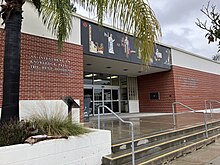
Gardena Mayme Dear Library, a 16,000-square-foot (1,500 m) building located in Gardena, and Masao W. Satow Library, located west of Gardena in Alondra Park (El Camino Village), unincorporated Los Angeles County, are operated by the County of Los Angeles Public Library.
Wednesday Progressive Club sponsored the formation of the Gardena Library. In 1913 the Moneta Branch was formed. In 1914 the Gardena Library became a part of the Los Angeles County Free Library system. Due to annexation the library was transferred to the Los Angeles City Library Board. In 1919 the Strawberry Park branch was formed. In August 1951 the Gardena library came back to the county system. In 1958 the Strawberry Park and Moneta branches merged into the West Gardena Branch. The current Gardena library building was dedicated on December 5, 1964. In 1969 a fire forced the West Gardena branch to go to a new location. The current Satow building, dedicated on February 26, 1977, was named after a Japanese American in the community. The Gardena library received its current name on May 30, 1992, and was named after a library volunteer, who had died prior to the renaming.
Transportation

The city operates the GTrans bus services (formerly as Gardena Municipal Bus Lines).
The National Transportation Safety Board operates the Gardena Aviation Field Office in Harbor Gateway, Los Angeles; it is the regional headquarters of the NTSB Aviation Western Region.
Notable people
- Akwafei Ajeakwa, soccer player
- Paul Bannai, former city councilman and first Japanese American to serve in the California State Legislature
- Beau Bennett, retired hockey player born in Gardena who was the highest-drafted hockey player of all-time to be born and trained in California
- Polly Bergen, actress and singer; lived in Gardena and attended Gardena High School
- Gary Berland, professional poker player; won five World Series of Poker bracelets; born and raised in Gardena
- Ron Block, banjo player, guitarist and singer-songwriter
- Steven Bradford, 1978 Gardena High School graduate; first African American elected to the Gardena City Council (1997–2009); former California Assemblyman (2009–2014)
- Enos Cabell, third baseman with the Baltimore Orioles and Detroit Tigers; attended Gardena High School
- Ed Carmichael, gymnast, 1932 Summer Olympics bronze medalist in the vault.
- Wayne Collett, runner, 1972 Summer Olympics silver medalist in the 400 meter event; attended Gardena High School
- Dock Ellis, pitcher with the Pittsburgh Pirates; attended Gardena High School
- Charlie Evans, running back with the New York Giants and Washington Redskins; born in Gardena
- Robert L. Freedman, screenwriter and playwright; former resident of Gardena
- Gaston Green, running back with the Los Angeles Rams and Denver Broncos; attended Gardena High School
- H.B. Halicki, actor, filmmaker, stuntman; business owner in Gardena and premiered his Gone in 60 Seconds there in 1974
- Juaquin Hawkins, professional basketball player; played with the Houston Rockets during the 2002-2003 NBA season
- Lisa Leslie, Olympic gold medalist and Los Angeles Sparks basketball player; born in Gardena
- Blydell Martin, boxer
- Butch Patrick, actor; was living in Gardena and attending PAE when he auditioned for The Munsters
- Art Pepper, innovative jazz saxophonist; born in Gardena
- Paul Petersen, actor, novelist, activist; former resident of Gardena
- William Rosecrans, Union general, congressman, and ambassador to Mexico; owner of and resident upon (from 1869) "Rosecrans Rancho," the foundation upon which Gardena later emerged
- Kevin A. Ross, host of America's Court with Judge Ross; attended Gardena High School and served as the school's student body president
- Daewon Song, professional skateboarder; resident of Gardena
- George Stanich, high jumper and bronze medalist of the 1948 Summer Olympics; resident of Gardena
- Paul Tanaka, Mayor and council-member
- Dakarai Tucker (born 1994), basketball player for Hapoel Haifa of the Israeli Basketball Premier League
- Tyga, rapper; attended Gardena High School
- Billy Warlock, actor
- Robert Woods, Los Angeles Rams wide receiver
Sister cities
 Huatabampo, Mexico
Huatabampo, Mexico Ichikawa, Japan
Ichikawa, Japan
See also
- Gardena Municipal Bus Lines
- South Bay, Los Angeles
- Ascot Park, a closed racetrack in Gardena
References
- "Gardena: Community History in Words and Pictures". County of Los Angeles Public Library. Archived from the original on September 2, 2017. Retrieved January 11, 2015.
- "California Cities by Incorporation Date". California Association of Local Agency Formation Commissions. Archived from the original (Word) on November 3, 2014. Retrieved August 25, 2014.
- "Elected Officials". City of Gardena. March 31, 2016. Retrieved March 12, 2017.
- ^ Mazza, Sandy; Washicko, Cynthia (March 7, 2017). "Election 2017: Rachel Johnson takes razor-thin Gardena mayoral victory; two newcomers top City Council field". The Daily Breeze. Retrieved March 12, 2017.
- "2019 U.S. Gazetteer Files". United States Census Bureau. Retrieved July 1, 2020.
- "Gardena". Geographic Names Information System. United States Geological Survey, United States Department of the Interior. Retrieved October 11, 2014.
- "US Census Bureau". www.census.gov. Retrieved September 13, 2024.
- "USPS - ZIP Code Lookup - Find a ZIP+ 4 Code By City Results". Retrieved January 18, 2007.
- "Number Administration System - NPA and City/Town Search Results". Archived from the original on September 29, 2007. Retrieved January 18, 2007.
- "Cities with the Highest Percentage of Japanese in the United States". Zipatlas.com.
- "Toyota built Torrance into the second-largest home of Japanese Americans. Now, it's leaving". May 16, 2014.
- ^ Gardena Heritage Committee (2006). Gardena. Arcadia Publishing. p. 7. ISBN 978-0-7385-4676-6.
- ^ Gardena, p. 8
- Frequently Asked Questions: Gardena Archived April 13, 2006, at the Wayback Machine County of Los Angeles Public Library. Retrieved on March 27, 2010.
- Ferrell, David (December 14, 1998). "Living by Casinos, Losing by Casinos". Los Angeles Times. Retrieved January 4, 2015.
- Waldie, D. J. (March 15, 2017). "Draw, Stud, and Hold'em: A Brief History of Poker in L.A." KCET. Retrieved May 6, 2020.
- Reft, Ryan (August 22, 2014). "Redefining Asian America: Japanese Americans, Gardena, and the Making of a Transnational Suburb". KCET. Retrieved January 31, 2020.
- Morrison, Patt (September 13, 2022). "Moneta, Tropico, Lordsburg — where did L.A.'s phantom towns vanish to?". Los Angeles Times. Retrieved September 15, 2022.
- "Census of Population and Housing". Census.gov. Retrieved June 4, 2015.
- "Population and Housing Unit Estimates". United States Census Bureau. May 24, 2020. Retrieved May 27, 2020.
- "2010 Census Interactive Population Search: CA - Gardena city". U.S. Census Bureau. Archived from the original on April 3, 2015. Retrieved July 12, 2014.
- ^ "Gardena (city) QuickFacts". United States Census Bureau. Archived from the original on March 17, 2015. Retrieved March 10, 2015.
- "U.S. Census website". United States Census Bureau. Retrieved January 31, 2008.
- "Gardena".
- ^ Goodman, Adrianne. "toward EQUALITY : EXPLORING A WORLD OF DIFFERENCE : ON THE STREET Where You Live : GARDENA." (Article information ) Los Angeles Times. February 13, 1989. Special Section; Metro Desk p. 8. "In 1980, Gardena was about 31% Anglo, 23% black, 21% Japanese and 17% Latino. much of the city's Japanese population was placed in internment camps."
- Williams, Bob. "Gardena Stable After Years of Racial Change ." Los Angeles Times. August 20, 1978. Centinela-South Bay p. CS1. Retrieved on August 30, 2013. "A special 1978 census portrays Gardena as a stable, integrated and largely middle-class community after eight years of racial change, according to Mayor Edmond J. Russ." and "The city, which had a 56% Anglo population in 1970, ac- cording to the 1970 US ... In fact, the Japanese, Chi- nese, Filipino and other Asian proportions in the"
- Goodman, Adrianne. "Teacher Helps Japanese-Americans Brush Up on Their Heritage." Los Angeles Times. November 24, 1988. Retrieved on August 30, 2013.
- Fujita, Akiko (May 16, 2014). "Toyota built Torrance into the second-largest home of Japanese Americans. Now, it's leaving". The World. Public Radio International. Retrieved October 4, 2016.
- ^ "'Focal Point' for Community : Institute Perpetuates Japanese Culture." Los Angeles Times. September 1, 1988. Retrieved on August 30, 2013.
- ^ "Gardena Frequently Asked Questions." (Archive) County of Los Angeles Public Library. Retrieved on August 29, 2013.
- "Gardena Council Seats Japanese ." Los Angeles Times. April 24, 1966. Centinela-South Bay p. CS1. Retrieved on August 30, 2013. "After 35 years of incorporation this city, with a large Japanese population, has a Nisei on the City Council. Kiyoto K. Nakaoka is first Japanese to be elected to Gardena City"
- Yamamoto, J.K. (March 3, 2017), "Gardena Mayoral Candidate Ikejiri Emphasizes His Experience", Rafu Shimpo
- ^ Millacan, Anthony (February 2, 1992). "Presence of Koreans Reshaping the Region : Immigrants: A developing Koreatown in Gardena symbolizes changes a growing population is bringing to the area". Los Angeles Times. Retrieved July 25, 2021.
- "Contact DMI Archived April 21, 2009, at the Wayback Machine." Digital Manga. Retrieved on April 21, 2009. "Digital Manga, Inc. 1487 West 178th Street, Suite 300 Gardena, CA 90248"
- "No Border: 200 Annual Report." Nissin Foods Holdings. 42 (44/48). Retrieved on December 27, 2010. "Nissin Foods (U.S.A.) Co., Inc. (Corporate Offices & Gardena Plant) 2001 West Rosecrans Avenue, Gardena, CA 90249 U.S.A."
- Hevesi, Dennis. "Momofuku Ando, 96, Dies; Invented Instant Ramen." The New York Times. January 9, 2007. Retrieved on March 5, 2010.
- "History." Nissin Foods Holdings. Retrieved on December 27, 2010.
- "About Us Archived December 30, 2011, at the Wayback Machine." Marukai Corporation U.S.A. Retrieved on December 22, 2011. "1740 WEST ARTESIA BLVD. GARDENA, CA 90248" - Japanese version Archived January 20, 2012, at the Wayback Machine
- "Contact Us Archived August 19, 2009, at the Wayback Machine." National Stores. Retrieved on February 24, 2010.
- "Fallas Paredes expanding local presence." Austin Business Journal. Monday August 11, 2008. Retrieved on February 24, 2010.
- "City of Gardena ACFR" (PDF). Retrieved May 30, 2024.
- "Statewide Database". UC Regents. Archived from the original on February 1, 2015. Retrieved December 7, 2014.
- "California's 43rd Congressional District - Representatives & District Map". Civic Impulse, LLC.
- "Peary Middle School".
- "Henry Clay Middle School".
- "Peary Middle School History Archived September 30, 2007, at the Wayback Machine." Peary Junior High School. Retrieved on April 21, 2009.
- "Sage Park". Bridge Housing. Retrieved May 12, 2021.
Sage Park Apartments on the north side of the Gardena High School campus.
- "Contact Us." Junípero Serra High School. Retrieved on April 21, 2009.
- "Contact Maria Regina Catholic School Archived April 22, 2010, at the Wayback Machine." Maria Regina Catholic School. Retrieved on April 21, 2009.
- "St. Anthony of Padua Archived May 26, 2011, at the Wayback Machine." Roman Catholic Archdiocese of Los Angeles. Retrieved on April 21, 2009.
- . Pacific Jr./Sr. High School. Retrieved on May 7, 2023.
- "Gardena Christian Academy contact information Archived July 11, 2011, at the Wayback Machine." Gardena Christian Academy. Retrieved on December 26, 2010. "Address: Gardena Christian Academy & Preschool 16311 S. Western Ave. Gardena, CA 90247."
- "Torrance Health Center Archived February 1, 2015, at the Wayback Machine." Los Angeles County Department of Health Services. Retrieved on March 18, 2010.
- "Curtis Tucker Health Center." Los Angeles County Department of Health Services. Retrieved on March 18, 2010.
- "Post Office Location - GARDENA." United States Postal Service. Retrieved on December 6, 2008.
- "Post Office Location - SOUTH GARDENA." United States Postal Service. Retrieved on December 6, 2008.
- "Post Office Location - ALONDRA." United States Postal Service. Retrieved on December 6, 2008.
- ^ "Gardena Mayme Dear Library Archived March 9, 2009, at the Wayback Machine." County of Los Angeles Public Library. Retrieved on April 21, 2009.
- ^ "Masao W. Satow Library Archived March 26, 2010, at the Wayback Machine." County of Los Angeles Public Library. Retrieved on April 21, 2009.
- "Alondra Park CDP, California Archived June 6, 2011, at the Wayback Machine." U.S. Census Bureau. Retrieved on May 5, 2010.
- "Regional Offices: Aviation." National Transportation Safety Board. Retrieved on May 15, 2010.
- Jenks, Hillary. "Seasoned Long Enough in Concentration: Suburbanization and Transnational Citizenship in Southern California's South Bay". Journal of Urban History. 40 (1): 16. doi:10.1177/0096144213503941. S2CID 129479455.
- "Beau Bennett Stats and News". NHL.com. Retrieved October 4, 2022.
- "Former Jr. King Beau Bennett a fast riser". LA Kings Insider. July 25, 2013. Retrieved October 4, 2022.
- ^ Gardena Heritage Committee, "Images of America: Gardena," (San Francisco: Arcadia Publishing, 2006), 74-99
- "Charles Evans". Pro-Football-Reference.Com. Retrieved November 26, 2012.
- "Juaquin Juan Hawkins". Basketball-Reference.Com. Retrieved November 26, 2012.
- "Lisa Leslie". Biography.com. Retrieved February 23, 2019.
- Slonimsky, Nicolas; Theodore Baker (1992). Baker's Biographical Dictionary of Musicians, Eighth Edition. New York, New York: Schirmer Books.
- Winslow, Mike (October 19, 2011). "Tyga Returns To High School To Inspire Students". allhiphop.com.
- "Sister City Directory – SOCAL Sister Cities".
- "Sister Cities". April 26, 2016.
Further reading
- Williams, Bob. "Gardena Goes Its Way, Successfully ." Los Angeles Times. August 16, 1984. South Bay p. SB1.
- Yoshinaga, George. "HORSE’S MOUTH: Where to Eat in Gardena." Rafu Shimpo. Wednesday August 21, 2013.
External links
- Official website
- Jobs and business: Gardena Economic Development
| Gardena, California | |
|---|---|
| Government | |
| City departments | |
| Education | |
| Primary and secondary schools | |
| Other education | |
| This list is incomplete. Italics: Gardena High School is in the Los Angeles city limits but serves Gardena. Harbor Gateway Transit Center is near Gardena and has a Gardena postal address. | |
- Gardena, California
- Cities in Los Angeles County, California
- Incorporated cities and towns in California
- South Bay, Los Angeles
- Japanese-American culture in California
- Korean-American culture in California
- 1930 establishments in California
- Populated places established in 1930
- Korean communities in the United States

